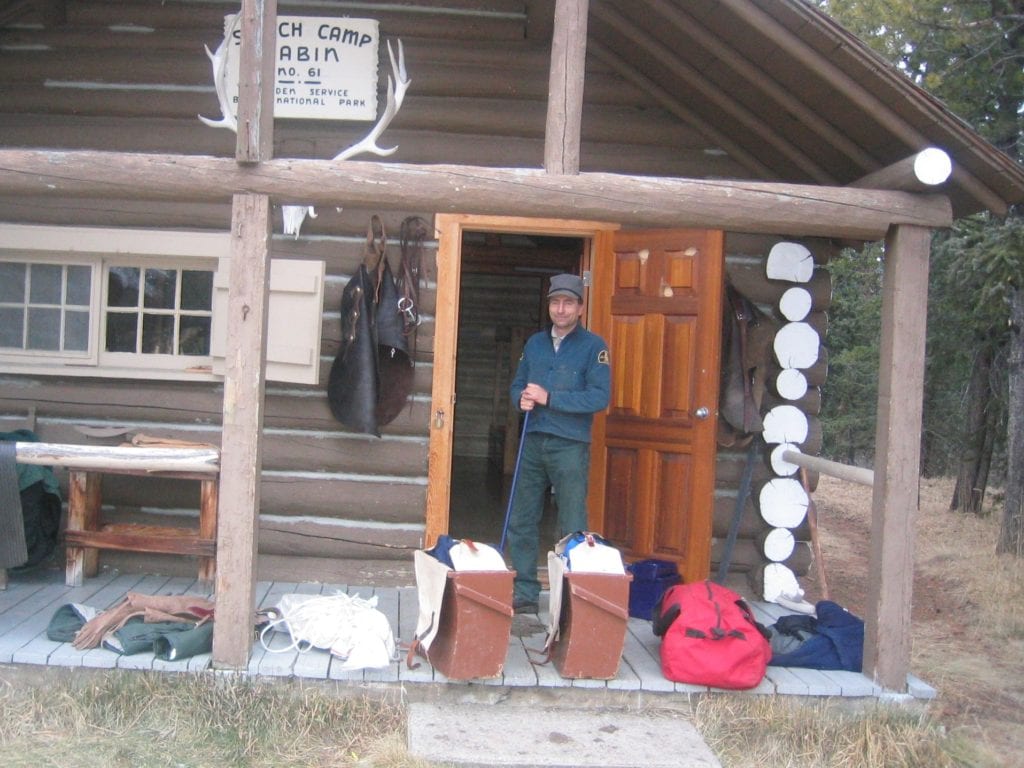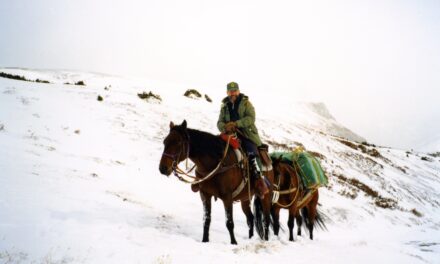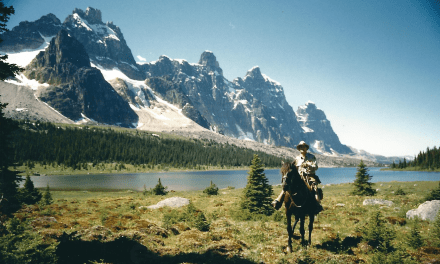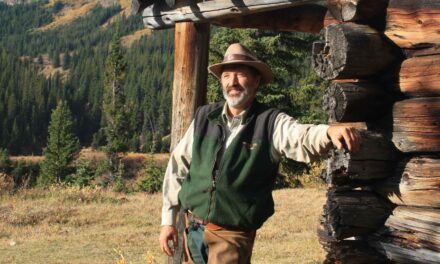“Dale (Portman – Jasper national park Dog Master spoke of that too.
(40:48) Oh yeah, there was huge pressure. spoke of that too, the pressure for you and your dog to perform.)
When you retired from being Dog Master, did the dog retire with you?
(40:58) I retired the dog, Data was getting to be almost eight. He was too old to give to somebody else (i.e. another Dog Master). So I gave him away to a young female RCMP constable who just kept him as a pet. She couldn’t use him because she wasn’t a certified dog handler, but she kept him as a pet and he lived another five years with her. She was stationed in Kananaskis and then she moved to Red Deer.
(41:28) My second dog Smokey went to live with Mike McKnight on his farm. He was an Assistant Chief warden in Lake Louise when I was there. My first dog Gypsy went up with Shawn Meggs to Nahanni park as his pet when she retired…My dogs all had good retirements. I was going backcountry as soon as I gave up Data and I couldn’t have a dog with me in the backcountry and I couldn’t just leave him home so I gave him up.
“Are there any humorous stories from your time with the service?”
(42:18) There were a few as a dog handler I had just got out of training with Data and these dogs you know have super high prey drives. So one of the things you have to do when you get back to the park is to teach them not to go roaring after animals right? We used to use a shock collar to give them a zap. Usually after once or twice and they were cured…So anyway with Data I hadn’t got around to using the shock collar yet. I had just got out of training and there was a suicide out at Lake Minnewanka. He left a suicide note in the car and we knew the body was somewhere up there. The first thing that I had to do was just check around the parking lot to make sure they just weren’t in the woods there somewhere. I took Data into the parking lot and his head came up like this (demonstrating) acting like he was indicating. I said, “What have you got?” Big mistake! The dog went WHOO and was gone. The next thing I know I hear yelling and shrieking and the dog had chased a herd of sheep right out into the day use area at Minnewanka there! Hundreds of people were shrieking as this dog went roaring through them. I was just so embarrassed. I just stayed back in the woods and hid waiting, thinking the dog is going to come back! Finally the dog came back, but that was embarrassing!
(43:47) Another funny one was, there was an armed robbery. Remember when Kentucky Fried Chicken used to be in town (in Canmore), down by where MacDonald’s is now? Well, they had the Kentucky Fried Chicken armed robbery. This guy comes in with a ski mask over his face and a knife and he demands the cash drawer. So the girl starts to take the money out and he goes, “No, I want the whole cash drawer!” She pulls this cash drawer out and gives it to him and he says, “God, it is hot in here!” And he lifts his ski mask up so everybody sees his face. It was like Dumb and Dumber! So he goes running out the door with this cash drawer and everybody outside sees a guy with a ski mask, a knife and a cash drawer and they watch him run across the street and into the bush going towards the curling rink. I got there 20 or 15 minutes after, cast the dog and picked up the track. We are going along and I find the knife, I find the ski mask and there are little bits of change all the way along that has fallen. We get to Lions Park and track right across Lion’s Park and then I lose the track on the pavement. As soon as I lost it, we get a call saying a taxi driver has picked up some suspicious guy at Lion’s Park who offered him $200 to go to Calgary and now he is Rusticana (grocery store) buying smokes. “What should I do?” The cops said, “Continue towards Calgary and we will pull you over and take him down” So anyway they took him down. I had to go to court in Calgary to the Court of Queen’s Bench, a trial before judge and jury and give my testimony. His defense council had these pictures and he says, “Mr. Warden, can you tell the court what this picture is?” I said, “Yes that is a picture of Lions Park.” He said, “Is that where you tracked my client?” I said, “Yes, I tracked him right across Lions Park.” “And what does that sign say to the right hand side of the picture?” I looked closer, “It says “No dogs allowed.” That was his defense! Anyways, he got convicted. This guy was just sitting there in the prisoner box grinning like a fool the whole time. He was obviously a couple of bricks short of a load. So that was kind of a funny one.
“So you did a lot of work with the RCMP?”)
(46:00) A huge amount, yeah. I would say, probably 70% of my case load was RCMP stuff. There was a total agreement between the two organizations?’) We would train their dog handlers in avalanche searching for winter, stationed at various places in BC and they would provide training for us at Innisfail free of charge. Then their dog handler would assist us in major searches in the Park and then we would assist the RCMP when their dog handler wasn’t available. Of course their dog handler was one guy who covered half the province of Alberta. He was based out of Calgary and he was never available unless there was lots of heads up time. So I always got the first call and response for basically the Banff, Canmore, and Lake Louise detachments.
“So you had a good working relationship?”
Oh yeah, I knew all the cops here as well as I knew all the wardens in those days. I don’t think Mike Henderson (current Parks Canada Dog Master) has quite as much freedom as I had. He can’t respond to Canmore because they have decided that it outside the park and he doesn’t have any authority. But I think he assists the RCMP in Banff a fair bit. I had more freedom than he did. I even covered for Cochrane the odd time when the guy was away. It was a lot of tracking guys down in the middle of the night or anytime. Anybody that ran from the cops you were called to track. Anytime there was a high speed pursuit on the highway you had to follow in behind, not at chasing them, just at normal highway speed. But you were behind all the chase groups in case they hit the bush. They usually ran from their vehicles. Lots of drug searching and evidence searching a crime scene, looking for a fire arm or a knife, those types of things. The only ones that were scary were tracking some guy in the middle of the night.
“Was it just you and the dog?”
Well, you usually had an RCMP guy running behind you. But sometimes people weren’t fit enough to keep up. So you had to make a decision. You had a hot track and you knew that you are going to catch this guy, but if you wait for this guy behind you, you are not going to catch him. So being young and keen and maybe a little foolish, I would always just go with the dog and catch the guy. I was lucky to have never gotten shot. In later years they sort of learned to actually put super fit guys with me because there got to be more younger fitter cops around. Then I started having guys that I knew could go with me, quite often they would call out that guy as well as me. So then I did have backup. The first ever call I ever got, I ended up tracking down four guys and the cop couldn’t stay with me. I tracked down four criminals and brought them all in. The only reason I got them was because they were all terrified of the dog. That was the only reason I got away with it most of the time, because the dog is pretty intimidating right? A big German shepherd police dog.
(“Is there anyone from the service that you worked with who really stand out?
(49:48) Lots. In Pacific Rim national park, the guy that stands out for me is Rick Holmes. There is a guy who should be interviewed really. He came on as a seasonal warden in 1981. He was a bit older than I was, maybe five years older or something like that. It was his first assignment as a seasonal warden. He was an ex ski instructor guy from Jasper. I was really desperate for someone to go surfing with so I talked him into taking up surfing and he loved it. So he and I surfed together for the three years that I was there all the time. I just found him to be a really great guy to work with. He was one of these guys he was so enthusiastic that we just had a really good time working out there. He went on to become almost a west coast legend. He was there for probably 25 years and he became the main guy in charge of the west coast trail. He invented a whole bunch of the rescue systems and he became the dive master for Parks Canada. He became a really expert surfer and the best boatman they ever had out there. He became a rescue specialist for the west coast trail and he mentored all sorts of young guys on the west coast trail over the years. So he stands out from my Pacific Rim days. He’s retired now, he lives somewhere around Nanaimo, or he might still be in Tofino, I am not sure. His wife was Heather Plews was the park biologist at Pacific Rim.
(51:45) The other guy of course I really admired up there (in Pacific Rim) was Gordie McClain. I’d say he really stuck out in my mind as a mentor and just a really great guy to work with. The coolest head that I have ever seen in an emergency. And then Mac Elder sticks out in my mind too as sort of my favorite Chief Warden over the years. I knew Mac since I was a kid, right. I just always admired him as a warden and it was great to work for him when he was the Chief Warden.
(52:28) Then in Banff I would say that your dad and I were really good friends. We started out as seasonal wardens together. We kind of went through the system together. We made lots of backcountry trips and did a lot of ski stuff. And Tim. (Tim Auger was the Public Safety Specialist for Banff National Park) I worked for Tim for 17 years, he was my supervisor. We got along great. He sticks out in my mind a lot.
“What was it about Ed?)
(52:52) Of the old time wardens I would say Jack Woledge, Ed Carleton and Bill Vroom were the three that I became the best friends with. He was a really nice guy yeah He would give you the shirt off his back. And Bill Vroom of course when I first showed up and John Wackerle too. Vroom and Wackerle were the two public safety guys when I first showed up in Banff Park. So they were kind of like the warden gods to everybody, those two guys. Bill Vroom was sort of the first warden I would say…like in our generation a lot of guys became super all around, like they could do everything from horses to climbing to skiing, they had all the skills. I would say Bill Vroom was the first of his generation to sort of achieve that, that all around capability. And Wackerle also was the same. Although Bill was a better horseman than Wackerle, but Wackerle was certainly decent with horses and Wackerle was a good mountaineer and the best skier the warden service has ever seen probably. Earl Skjonsberg sticks out in my mind too. He was a great guy, of the older generation.
“Did you learn any of your dog skills from Earl?”
(55:02) I didn’t actually. Earl had retired by the time that I took over the job. I did some tracks and stuff for him when I was a warden, but I learned it all by going to the training with the RCMP. The training courses there were great, you learned a huge amount. By the time I went in with Data, I had him pretty much fully trained before I went in there just about. I spent six months there the first time and with Data I was only there five weeks. Basically I just had to pass all the three levels of tests. So I spent five weeks in testing basically. Data was also the youngest dog to ever graduate from the RCMP training program. He still hasn’t been surpassed to this day. He was ten months old when he graduated, which is unheard of. Most times even 12 months is too young, usually they are 14 to 16 months when they graduate. He was a super capable dog. The RCMP thought so highly of Data that they wanted to breed him, get pups off him for other dogs. But it turned out that when they really looked at the genetic stuff, they figured it would be a small chance that those same attributes would come through the pups.
“Is there anything about the warden service as you knew it that you would want future generations to know?”
(56:45) Well just the biggest strength we had was the multifunctional ability of the wardens.) The jack of all trades type of thing. We had a whole team of men and women who could do a multitude of tasks on any given day. It was very efficient…If it’s like today where you are only a law enforcement warden you could sit around for two months in the winter waiting before a law enforcement call comes up. But in our day you would respond to a law enforcement call if it came up and in the meantime you would be doing problem wildlife work or a biology study, or working avalanche control, or doing public safety. There was a multitude of tasks. At the drop of a hat you could respond to any situation, whereas now it is so fractionalized and so specialized that you don’t have that functional capability of everybody being able to do everything. Now people are just doing one thing. What do they do when it is not as busy in that one department? So I think that they really missed the boat when they went away from that. That was about 2006 or something like that. It was not that long ago. I retired in 2005 and it was still a multifunctional, I was a backcountry warden. It was all because of the sidearm issue. I am sure you are totally familiar with that.
(In 2000, Banff warden, Douglas Martin filed a federal Labor Code Complaint arguing that, without a side arm, he was being placed in situations of potential danger without the necessary protective equipment. (Remington, Robert. “Men for the Mountains.” Discovering Alberta – A Calgary Herald Magazine Series). After seven years of discussions and appeals, the National Occupational Health and Safety Policy Committee recommended that Parks Canada give wardens side arms. However, wardens were later relieved of their law-enforcement duties, with the exception of enforcing federal conservation laws. “In 2008, the union complained wardens could be mistaken for police officers because of their uniform and cars and that they were still unable to protect themselves. Parks Canada has since ruled that wardens will dress like any other park employees and 100 armed-enforcement officers were hired. These 100 officers are now the only employees with the warden title and uniform. They are in charge of protecting Canada’s 41 national parks and park reserves.” (Agrell, Siri. “Park Wardens Our of Uniform: From Stetsons to Ball Caps” Globe and Mail. June 7, 2008.)
When they finally decided to arm the wardens they said if you looked at a warden job description it said 25% law enforcement, so they said “Okay, we will arm 25% of you.” Those ones would be wardens and the rest would be generic park staff doing these other duties. They split it all up into wildlife, public safety and law enforcement. It was kind of three separate entities and never shall the three meet. I know the law enforcement guys here say that they are totally understaffed in the summer and over staffed in the winter. Actually they aren’t even over staffed because they lay the poor people off. They can’t even have full time jobs as a law enforcement warden. They work in the summer and then they get laid off for two or three months in the winter. There is only a couple of them around in the winter. So it is totally brutal. Just when you think that it can’t get any worse it keeps taking a bigger nose dive every year.
“Don (Mickle retired Banff warden) said it has gone so extreme one way that it might eventually come back to a place that is reasonable?”
(59:57) I don’t think that it will ever come back to the way that it was. It might come back to something more reasonable. It is pretty sad. You know the brand new people that are new to the job now, they don’t know the difference they probably think that it is the greatest job going. I think the best job now is probably just straight resource management or public safety. Law enforcement was always sort of a negative aspect of the job, not the most fun part dealing with yahoos. The fun parts of the job were public safety, backcountry that kind of stuff, working with wildlife. So the actual park warden nowadays is only law enforcement. Park wardens also had a great reputation Canada wide because of public safety and being seen in the backcountry. There is a romantic image about them. I think that is going to fast fade when all they are going to be associated with is the negative aspects of the job, like giving people tickets. They will be about as popular as the bylaw enforcement.

Scott at Scotch Camp on the Red Deer River in the fall.
“Do you think it was that multifunctional role that made the warden service so unique?”
(1:01:39) Yeah. And the wide range of mountain skills that the wardens had. It gave us quite a bit of respect with the public. You know a horse outfitter has got the horse skills, mountain guides have the climbing skills and a ski patroller has those skills, but the only person in the mountains that had all those skills, who had to master all those skills was the park warden. You learned an incredible array of mountain skills by being a park warden.
“Do you think that also contributed to the camaraderie?”
(1:02:26) Oh definitely.) That and being on big rescues together, and I think doing backcountry trips together for ten days at a stretch. You either became comrades or you hated them, one of the two! It wasn’t all roses! There were conflicts over the years between various people. It’s funny because it is a typical warden thing and in the district system it was the same too, two wardens might fight like cats and dogs, but heaven help you if somebody from the outside criticized them. They stuck together, it was like a family really. You fight in the family, but you still have the feeling of family. Camaraderie right? Like even today, we’ve retired, Donny and I, now for eight or nine years and we still hang out every day, Gord Antoniuk, Jim Murphy, we still all hang out, all the time.



